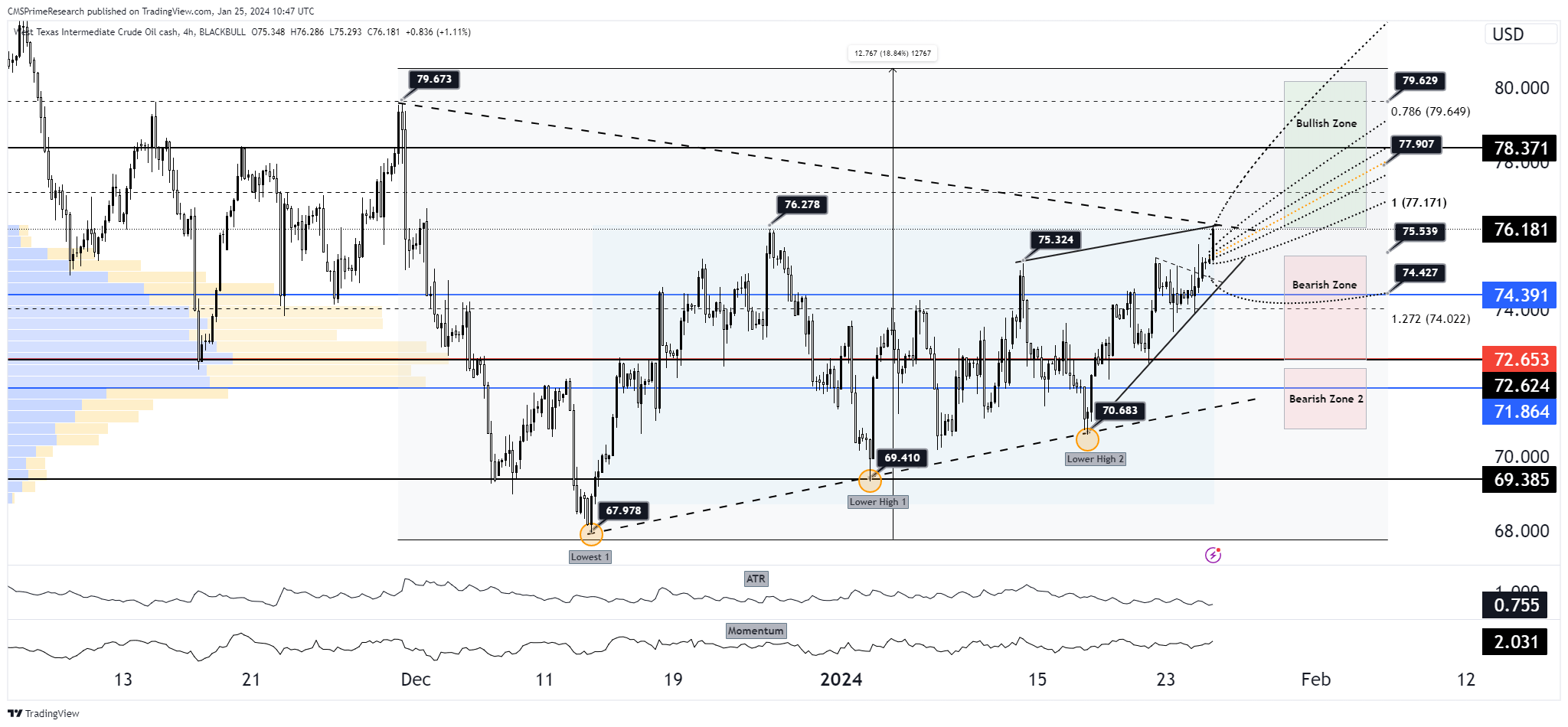
Current Factors Influencing Current Crude Oil Prices:
- Drawdown in US crude inventories: On January 25th, data showed US crude stockpiles fell by over 9 million barrels, much more than expected. This inventory draw supported higher oil prices.
- Hopes for China economic stimulus: On January 25th, China’s central bank announced a reserve ratio cut for banks that will inject $140 billion into the economy. Hopes this will boost China’s oil demand outlook supported higher prices.
- Geopolitical tensions in the Middle East: Tensions in the Middle East were cited as an additional factor behind buying and higher oil prices on January 25th.
- Weaker US dollar: The US dollar weakened slightly against other major currencies like the Euro and Yen on January 25th based on currency market movements. A weaker dollar makes oil cheaper for holders of other currencies, supporting demand.
In summary, the largest price drivers on January 24th-25th were the larger than expected drawdown in US crude inventories and hopes for more economic stimulus in China. Geopolitics and currency moves provided additional support.
Technical Analysis

Price Action and Chart Patterns:
- The chart displays a bullish trend with higher lows, as indicated by the ascending trendline.
- The most recent price action has breached previous resistance at approximately $76.28, suggesting a strong bullish sentiment.
- The chart indicates a potential “Bullish Zone” if prices stay above the 0.786 Fibonacci retracement level at $79.649, and a “Bearish Zone” below the 1.272 extension at $74.022.
Support and Resistance Levels:
- Key resistance is marked at $79.673, which could be the next target for bulls.
- Support levels are identified at previous price pivots: $67.978 (Lowest 1), $69.410 (Lower High 1), and $70.683 (Lower High 2).
Fibonacci Retracement and Extension:
- The Fibonacci tool has been used to identify potential reversal zones. The price is currently approaching the 0.786 retracement level, a zone that could act as resistance.
- Fibonacci extension levels are also plotted, with the 1.272 extension level demarcating the start of the “Bearish Zone.”
Technical Indicators:
- ATR (Average True Range): The ATR is trending upwards, indicating increased market volatility.
- Momentum Indicator: The Momentum indicator is also trending upwards, which typically signifies increasing buying pressure.
Overall Market Sentiment:
Positive Sentiment: 70% – This rating is based on the bullish trend, the breach of resistance, the upward momentum, and the proximity to the bullish zone in Fibonacci levels.
Negative Sentiment: 15% – This is reflected by the nearness to key resistance levels, which may prompt profit-taking or a pullback.
Neutral Sentiment: 15% – Uncertainty arises from the fact that the market is at a critical junction near the 0.786 Fibonacci retracement level, and it remains to be seen if it will hold as resistance or if the price will consolidate.
The analysis indicates that while the market is currently showing strong bullish signals, traders should be cautious as the price approaches significant resistance levels. A definitive break above the 0.786 Fibonacci level could confirm the continuation of the bullish trend, whereas a rejection from this level could lead to a retest of lower support zones. It’s also important for traders to keep an eye on external factors such as oil inventories, geopolitical events, and economic data releases that can greatly affect oil prices.
Price analysis and Targets:($72-$79)
Scenario 1: Price Decline to $72
If WTI crude oil prices were to decline from their current levels toward the support level at $72, there are several factors that could drive this movement:
Oversupply Concerns: Analysts anticipate that oversupply issues could persist into 2024, contributing to weaker prices. An increase in production from countries outside OPEC+ could exacerbate this oversupply, especially if U.S. production continues to grow, albeit at a slower pace.
Economic Conditions: Continued economic worries, especially in significant economies, could dampen demand for crude oil. Analysts point to economic concerns as a factor that will moderate oil demand, which could put downward pressure on prices.
Technical Resistance: From a technical perspective, failure to breach significant resistance levels, like the one near $79, could lead to a reversal in trend, pushing prices down toward the support at $72.
Seasonal Demand Fluctuations: Seasonal decreases in demand, particularly post-winter, could lead to inventory builds that pressure prices downward.
How the Market Might React: In response to a decline in prices, we might see a scaling back of production in certain regions, as lower prices reduce the incentive for drilling and exploration. This could eventually lead to a balancing of supply that supports prices. The market sentiment in this scenario could be cautiously pessimistic, with traders and investors monitoring for signs of stabilization or further declines.
Scenario 2: Bullish Continuation to $79
Conversely, if bullish sentiment is sustained and WTI crude oil prices reach $79, several factors could be driving this trend:
Geopolitical Tensions: Events in geopolitically sensitive regions, such as the Middle East, can significantly impact oil prices. Continued tensions or disruptions in these areas could lead to concerns about supply shortages, driving prices up.
Economic Recovery: If the global economy shows stronger-than-expected recovery signs, this could lead to increased demand for oil, thus pushing prices higher.
Technical Breakouts: A break above key resistance levels could lead to a surge in bullish sentiment, driving prices toward or above the $79 mark as traders anticipate further gains.
Supply Adjustments: OPEC+ decisions to cut production or slower-than-expected production growth in the U.S. and other non-OPEC countries could tighten the market and support higher price levels.
How the Market Might React: Should prices rally to $79, it could signal strong market confidence in continued demand and potentially tighter supply conditions. This could lead to an optimistic market sentiment, with investors and traders potentially looking for further upside potential.
Influence Factors for Both Scenarios:
- Supply and Demand Fundamentals: Fluctuations in global inventories, OPEC+ production decisions, U.S. shale oil responses, and changes in demand from major consumers like China and India.
- Macroeconomic Trends: Central bank policies, currency fluctuations (particularly the USD, in which oil is traded), and broader economic indicators could influence investor sentiment and speculative trading.
- Technical Indicators: Moving averages, RSI levels, and Fibonacci retracements could provide traders with signals that influence their trading behavior, thus impacting prices.
In conclusion, the future direction of WTI crude oil prices will be determined by a complex interplay of supply and demand dynamics, geopolitical developments, technical chart patterns, and macroeconomic trends. Market participants will closely monitor these factors to gauge the potential for either scenario to unfold.
What Kind of Technical Patterns we Should Observe
In the event of a price decline to the support level at $72, the following technical factors and reactions may come into play:
Liquidity and Order Flow: As prices approach key technical support levels, like $72, there’s often an increase in liquidity as buyers place orders to enter the market at these perceived value areas. Conversely, sellers may also aim to capitalize on the downtrend, resulting in a push-pull dynamic at this price point.
Absorption at Support: If there is sufficient buying interest at the support level, we may observe price absorption, where the market absorbs the selling pressure without breaking the support. This can indicate that the market is not ready to move lower and could potentially reverse.
Volatility and ATR Increases: As prices descend toward a known support level, volatility often increases, reflected by a rising ATR (Average True Range). Traders and investors may anticipate significant price movements, which can lead to wider price ranges and more significant intraday swings.
Volume Analysis: A drop in prices on increasing volume can indicate strong selling pressure. Technical analysts will monitor volume for signs of capitulation, where high volume and declining prices may suggest that sellers are becoming exhausted, setting the stage for a potential reversal.
Break of Support and Stop Runs: If the $72 support level is decisively broken on high volume, this could trigger stop-loss orders placed below the support. The execution of these stops can exacerbate the downward move, potentially leading to a liquidity vacuum and a sharper price decline.
Technical Analysis for Scenario 2: Bullish Continuation to $79
In the case of a continued bullish trend leading to prices reaching $79, here’s what might be observed from a technical standpoint:
Breakout Volume: A move towards $79 would likely be accompanied by increased volume, signaling strong buying interest. A breakout above resistance, particularly on high volume, would confirm the strength of the bullish trend.
Volatility Expansion: As prices approach and potentially break through resistance, we can expect volatility to expand. This is typically measured by a rising ATR, indicating that the price range is widening as the market becomes more aggressive.
Momentum Increase: Indicators such as the RSI or MACD may show increasing momentum as the price nears the resistance level. A strong bullish momentum can help the price to break through the resistance level.
Order Flow Dynamics: A sustained move towards $79 may attract more buyers, creating a positive feedback loop. As more traders anticipate a breakout, the increase in buying orders can create upward pressure on prices.
Resistance Turned Support: If the price does break above the $79 resistance, that level could then become a new support level. Traders often watch for a ‘retest’ of this level, where price approaches the breakout point from above, testing it as support.
Liquidity Above Resistance: Often, there is liquidity located just above key resistance levels, as traders place stop orders above this level to capture the breakout. When these stops are triggered, they can create additional buying pressure, propelling the price further.
Both scenarios will undoubtedly be affected by real-world events and changes in market fundamentals, but from a technical standpoint, these are some of the key considerations that traders will be watching for as they make their trading decisions.
Conclusion
In summary, the current factors influencing oil prices include a significant drawdown in US crude inventories, hopes for economic stimulus in China, geopolitical tensions in the Middle East, and a weaker US dollar. Technical analysis reveals a bullish trend with potential support and resistance levels to watch. Two possible scenarios for oil prices are a decline to $72 driven by oversupply concerns and economic worries, or a bullish continuation to $79 fueled by geopolitical tensions, economic recovery, and technical breakouts. Regardless of the scenario, supply and demand fundamentals, macroeconomic trends, and technical patterns will play crucial roles in determining the future direction of oil prices. Traders and investors will closely monitor these factors to make informed decisions in this complex and dynamic market.
To know more about CMS Prime visit us at https://cmsprime.com
Disclaimer: This is not an Investment Advice. Investing and trading in currencies involve inherent risks. It’s essential to conduct thorough research and consider your risk tolerance before engaging in any financial activities.


